栀子苷的含量测定
- 格式:doc
- 大小:36.50 KB
- 文档页数:5
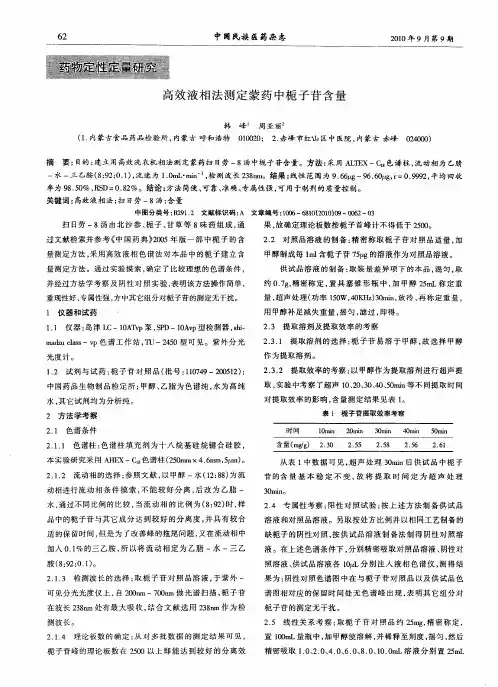
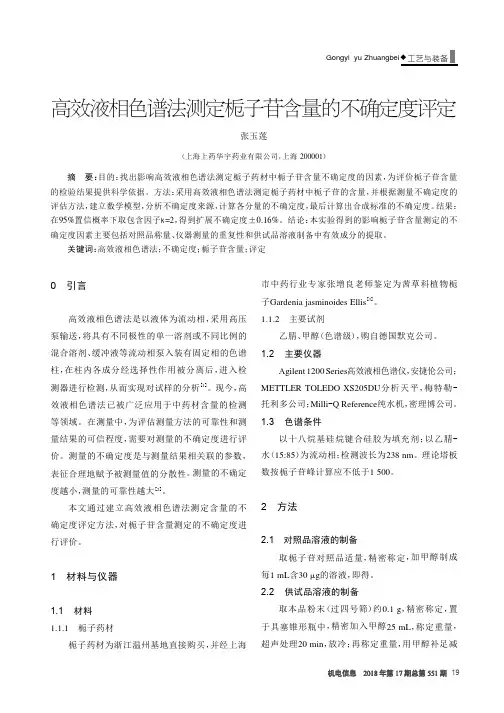
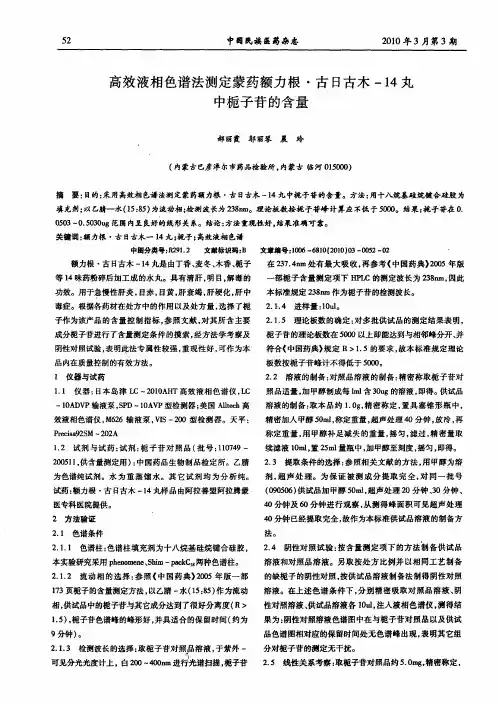
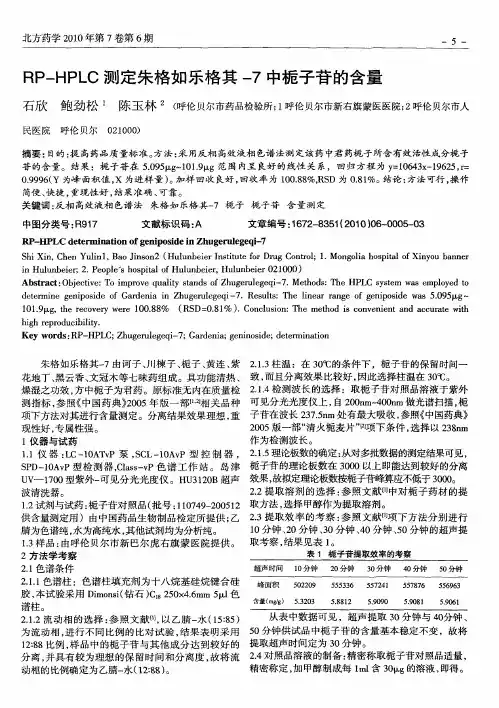
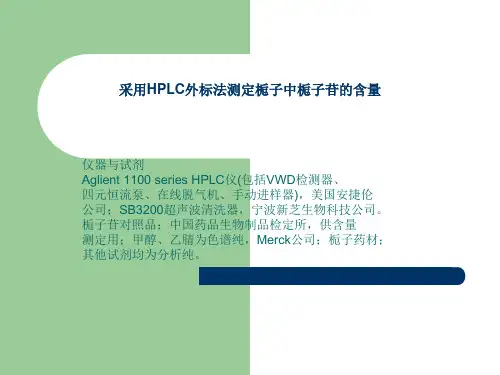
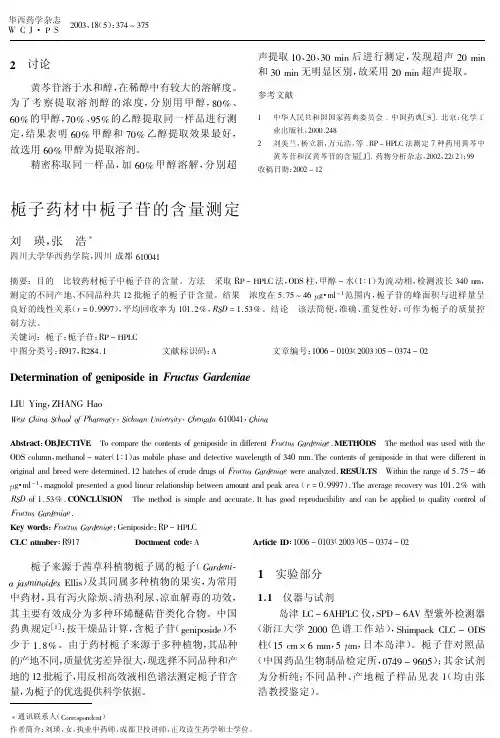
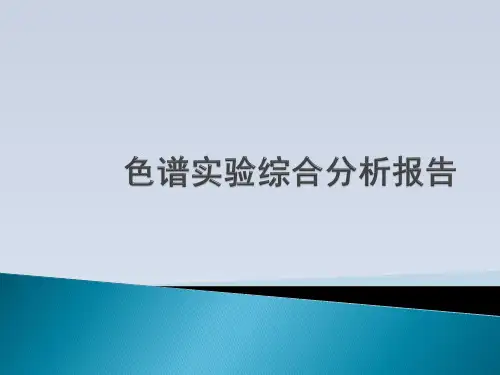
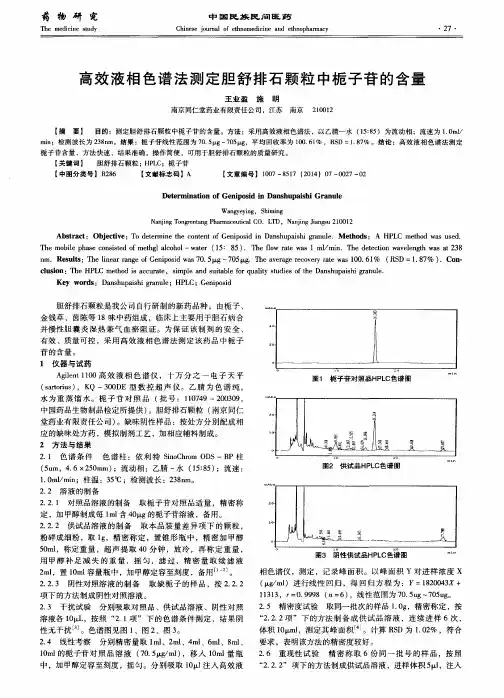
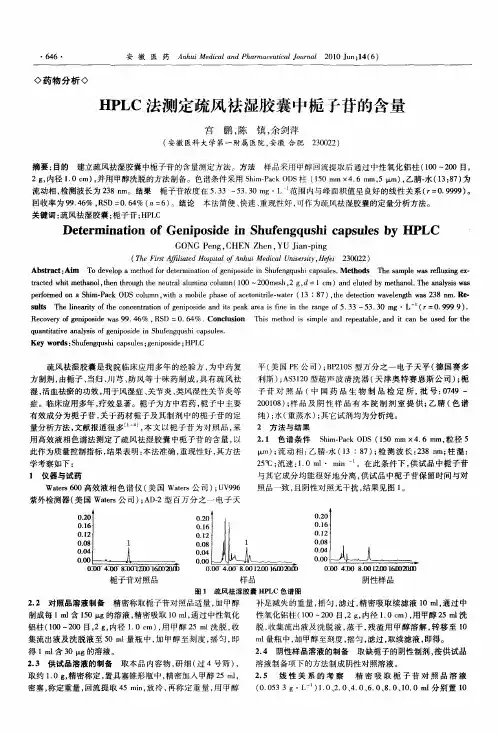
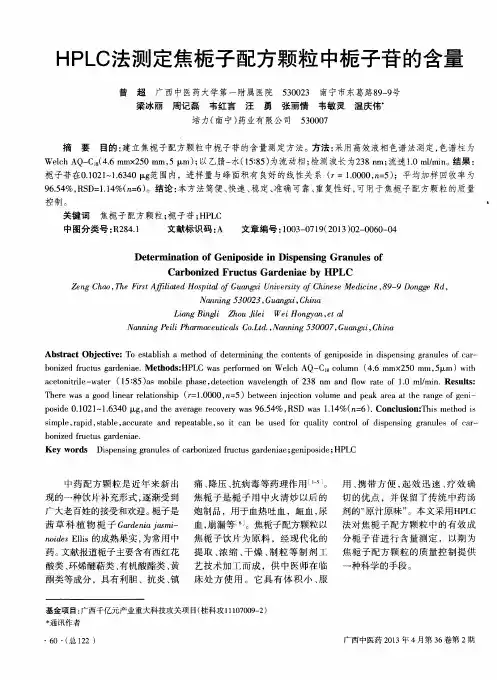
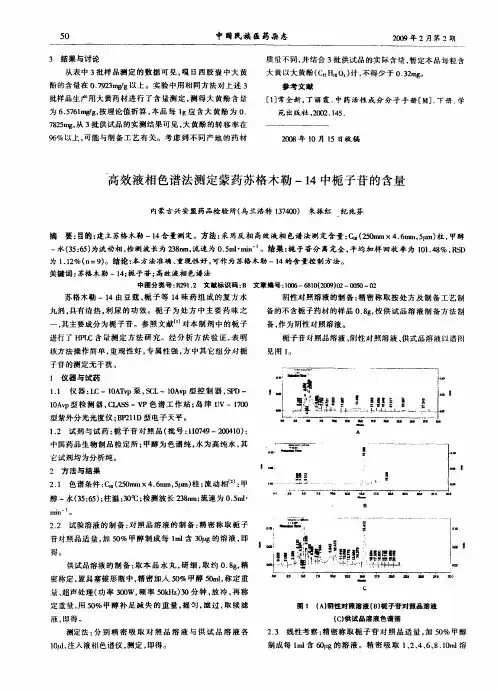
高效液相色谱波长转换法测定西红花苷-1和栀子苷的含量1. 研究背景西红花和栀子是常用的中药材,具有清热解毒、活血化瘀、凉血止血等功效。
其中,西红花中含有多种高效的生物活性成分,如西红花苷-1、四氢西红花苷-1、中环倍半萜醇等;栀子中主要含有栀子苷、槐黄等成分。
这些成分对于中医药的疗效起着重要的作用。
为了保证中药材的质量,需要对其生物活性成分进行定量分析。
各种成分的分离和测定已经成为中药化学分析的重要手段之一。
高效液相色谱(HPLC)技术在中药生物活性成分分离和测定中得到了广泛的应用,并已经成为中药材生物活性成分分析的标准分析方法。
而波长转换技术是HPLC技术中的一种重要手段,可以实现多分离波长的自动选择,提高检测的准确度和效率。
2. 实验目的本实验旨在建立高效液相色谱波长转换法测定西红花苷-1和栀子苷的含量的方法,为中药材的质量检测提供科学依据。
3. 实验步骤3.1 实验仪器和试剂实验仪器:Agilent 1260高效液相色谱仪检测波长:280 nm (西红花苷-1)、330 nm (栀子苷)色谱柱:Zorbax SB-C18(4.6 mm×250 mm,5 μm)移液器、瓶塞、定量瓶、滤膜、紫外可见分光光度计等试剂:西红花苷-1、栀子苷(国药集团药材有限责任公司药材分公司)碳酸氢钠、甲醇、乙腈(优级色谱纯)3.2 样品制备将0.5 g的西红花或栀子粉末分别取出,加入50 mL甲醇,剧烈摇晃2 min,静置10 min,然后过滤,取滤液20 mL,再用1%碳酸氢钠调整pH至8.5-9.0,加入50%乙腈0.5 mL,摇匀备用。
3.3 色谱条件流动相:甲酸水-乙腈(A:B=75:25)洗脱条件:0-17 min,B梯度升至50%;17-22 min,B梯度升至80%;22-24 min,B梯度降至75%。
流速:1.0 mL/min进样量:10 μL3.4 标准品制备将西红花苷-1和栀子苷分别加入定量瓶中,用甲醇稀释至一定浓度,制成1 mg/mL的标准溶液,再逐步稀释至0.1、0.2、0.4、0.6、0.8和1.0 μg/mL的标准溶液,分别进行HPLC检测。
高效液相色谱法测定栀子药材中栀子苷的含量实验目的和要求1.掌握高效液相色谱法的基本原理及操作步骤;2.熟悉高效液相色谱法在中草药有效成分测定中的应用。
实验原理高效液相色谱法是用高压输液泵将具有不同极性的单一溶剂或不同比例的混合溶剂、缓冲液等流动相,泵入装有固定相的色谱柱,经进样阀注入供试品,由流动相带入色谱柱,在柱内各组分被分离后,依次进入检测器,色谱信号由记录仪或积分仪记录。
所用的仪器为高效液相色谱仪。
色谱柱的填充剂和流动相的组分应按待测组分的性质而定,常用的色谱柱填充剂有硅胶和化学键合硅胶,后者以十八烷基键合硅胶最为常用,辛基硅烷键合硅胶次之,氰基或氨基键合硅胶也有使用。
除另有规定外,柱温为室温,检测器有紫外检测器,二极管阵列检测器,示差折光检测器等。
影响色谱分离效率有两大主要因素,其一为热力学因素, 如不同组分容量因子(K’),其二是动力学因素, 如色谱峰的展宽。
反映这些物理过程的指标是保留时间和理论塔板数(N)。
其中K’=t R-t o / t o ;n = 5.54(t R / W1/2)2密切注视和努力解决这两个因素引起的矛盾,组分间的分离就成功了,分离的表现指标是分离度“R”。
R = 2 (t2 - t1) / (W b1+W b2)实验条件1.仪器:高效液相色谱仪,超声波清洗器,Zorbax C18柱(4.6×250mm)。
2.试剂:栀子苷对照品,乙睛,甲醇,水。
实验内容1.色谱条件:色谱柱:Zorbax C18柱(4.6×250mm);流动相:乙睛—水(15:85);检测波长:238nm,流速:1mL/min。
2.对照品溶液的制备和标准曲线的绘制:精密称取栀子苷对照品适量,加甲醇制成每1mL含100μg的溶液,摇匀后,分别取该液1,2,3,4,5mL,置10mL容量瓶中,加甲醇稀释至刻度,摇匀后,分别进样20μl,按上述色谱条件测定,以峰面积为纵坐标,浓度为横坐标绘制标准曲线,计算回归方程和相关系数。
3.供试品溶液的制备:取本品粉末0.1g,精密称定,置25mL量瓶中,精密加入甲醇20mL,超声处理30min s。
放冷,加甲醇至刻度,摇匀,滤过。
精密量取续滤液5mL,置25mL容量瓶中,加甲醇至刻度,摇匀,过微孔滤膜,取续滤液,作为供试品溶液。
4.测定法:吸取供试品溶液20μl注入液相色谱仪,测定。
由标准曲线法或一点法计算样品中栀子苷的含量(C17H24O10)。
五实验记录1.扼要说明操作步骤及实验结果;2.绘制标准曲线图,及回归方程,相关系数;六思考题1.在仪器操作过程中,应重点注意哪些方面?2.用HPLC法测定中药中有效成分含量的主要优势是什么?Experiment 2 Determination of Gardenoside in Fructus Gardeniae by HPLCClass hour: 6Objectives1. Master the principles and operational method of HPLC through this experiment.2. Be familiar with the use of HPLC in determination of components in traditional Chinese medicine.PrinciplesIn high performance liquid chromatography, the mobile phase, a solvent or a solvent mixture of suitable polarity (or a buffer solution of suitable ion strength), is pumped into a column containing the stationary phase. While the sample is injected into an injector and carried into the column by the mobile phase, the components are separated on the stationary phase and each component passes through the detector in succession and thus a chromatogram is record.The stationary phase and the component part of the mobile phase should be in accordance with the qualities of test samples. Silica gel and chemically bonded silica gel are commonly used as the bulking agent. For chemically bonded silica gel, octadecylsilane type is most frequently used, followed by the octylsilane type, and the cyano and amino group bonded silica gel are occasionally used. The column is maintained at room temperature. The type of detector includes UV, DAD, SPD and so on.There are two important factors responsible for chromatographic separation efficiency. One is the thermodynamic factor, such as the capacity factor of different components (k’), the other is the dynamic factor, such as the width of peak. The indexes to reflect these physical processes are retention time (t R) and the number of theoretical plates of column (n). Calculate the value of k’and n as follows:k’ = (t R-t o) / t o; n = 5.54 (t R / w1/2)2The separation of different components will be successful if close attention is paid and great effort is taken to solve the contradiction caused by the above factors. The ter m “resolution factor” is often used as an index to express separation efficiency. Calculate the value of R as follows: R=2 ( t2-t1 ) / ( w b1+w b2 )Conditions1.Apparatus HPLC instrument coupled with an ultraviolet detector, Column: Zorbax C18(4.6×250mm, ultrasonic cleaner.2.Reagents Fructus gardeniae, gardenoside CRS, acetonitrile, methanol, water.Assay1. Chromatographic systemUse octadecylsilane bonded silica gel as the stationary phase and acetonitrile –water (15:85) as the mobile phase; flow rate: 1.0 mL/min; the wavelength of the detector is 238 nm and the column temperature is set in room temperature.2. Preparation of the stock solution and the standard curveThe stock solution is prepared by dissolving a quantity of gardenoside CRS in methanol to produce a solution containing 100 µg per mL. Then transfer the stock solution 1, 2, 3, 4 and 5mL to five 10mL volumetric flasks, and dilute with methanol to the volume respectively. 20µL of each of solution is analyzed using the chromatographic system showed above. The standard curve is obtained by plotting concentration versus peak area and corresponding coefficient are also calculated.3. Preparation of test solution0.1g of the sample is weighed and contained in a 25 mL volumetric flask. Add accurately 20 mL of methanol to the flask, extract for 20 mins in an ultrasonic cleaner. After that, take it out and allow it to cool. Add methanol to the mark of the volumetric flask. Shake it well and filter. After filtration, transfer accurately 10 mL of the successive filtrate to another 25 mL volumetric flask and dilute to the volume with methanol. Then the solution are mixed well and filtered with millipore membrane (particle size 0.45 µm). Thus, the successive filtrate is used as the test solution.4. Procedure20 μL of test solution is injected accurately into the column, and the content of the sample is determined according to the standard curve or one point method.Experiment records1. Describe briefly the process of this experiment.2. Plot the standard curve and calculate the regression equation and the relative factor. Questions1. What should be paid attention to in the operating of the instrument?2. What are the main advantages of HPLC in the determination of the components in Chinese medicines?。